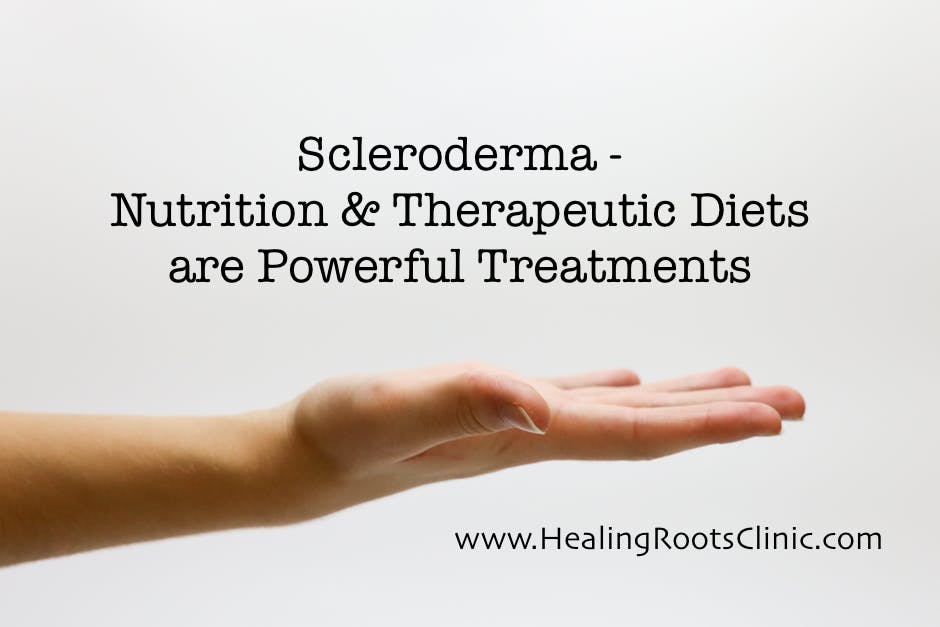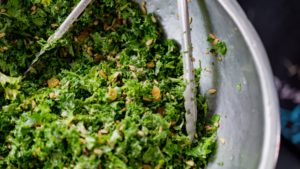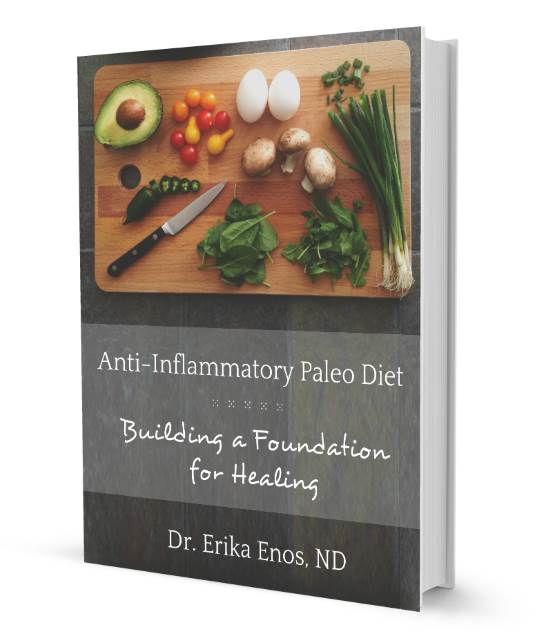 We are lucky to live in a time when the power and importance of nutrition is becoming widely known and accepted. I believe that virtually any condition can be improved by nurturing your body with the right foods, and scleroderma is no exception. I’m going to share a patient’s dramatic story to illustrate this. My goal is to not only inspire those with scleroderma to use nutrition as a powerful healing tool but to firmly establish finding the right diet as a necessary foundation for healing in any case of autoimmunity or other chronic disease.
We are lucky to live in a time when the power and importance of nutrition is becoming widely known and accepted. I believe that virtually any condition can be improved by nurturing your body with the right foods, and scleroderma is no exception. I’m going to share a patient’s dramatic story to illustrate this. My goal is to not only inspire those with scleroderma to use nutrition as a powerful healing tool but to firmly establish finding the right diet as a necessary foundation for healing in any case of autoimmunity or other chronic disease.
A therapeutic diet means that for a certain amount of time you will eliminate or limit certain foods and also increase nutrient-dense healing foods that will restore your body to balance. Afterward, you’ll transition to a long-term, whole-foods based diet.
What is Scleroderma?
If you are not familiar with scleroderma, it falls under the category of connective tissue autoimmune diseases. This category also includes:
- lupus
- polymyositis
- dermatomyositis
- rheumatoid arthritis
Connective tissues are the parts of the body that connect everything together and are made up of two substances, collagen, and elastin. Examples of connective tissues include bones, cartilage, ligaments, tendons, and skin. In scleroderma specifically, an aberrant immune system triggers too much collagen production.
While collagen is a lovely thing in the right amounts because it plumps up the skin to keep us looking young, in scleroderma the overproduction can be quite dramatic, causing the skin to become shiny and taut. Over time, the excess collagen can cause stiffening, tightening, and contractures, and internal organs are often impacted as well.
Scleroderma: A Patient Story
Recently I had a new patient appointment with a young woman previously diagnosed with scleroderma. The autoimmune process was progressing largely unchecked and this was evident in her appearance. Her hands and fingers displayed a not uncommon finding of the disease: fingers curled downward in contracture. The skin covering her arms had become so shiny and taut from the tips of her fingers to her upper arm that taking her blood pressure and pulse was nearly impossible. The skin over her face had a similar look. You can only imagine how these physical changes impacted her life; she was unable to drive and could not continue her career that required the constant use of her hands.
Towards the end of this post, I will share with you her remarkable and inspiring response to a therapeutic diet and simple lifestyle changes.
Scleroderma: My Healing Approach
 Before doing extensive lab testing or prescribing herbs, nutraceuticals, or homeopathy for a patient, I help you lay a foundation that includes nutrition and lifestyle habits that are instrumental for healing. My approach to the healing process is to address the root cause which alleviates my patients’ symptoms and helps them feel better than they ever have before.
Before doing extensive lab testing or prescribing herbs, nutraceuticals, or homeopathy for a patient, I help you lay a foundation that includes nutrition and lifestyle habits that are instrumental for healing. My approach to the healing process is to address the root cause which alleviates my patients’ symptoms and helps them feel better than they ever have before.
This foundation of nutrition and lifestyle habits is indispensable. Here are just some of the reasons why…
Therapeutic diets clear the picture.
Every chronic disease has an inflammatory component, so it’s important to reduce systemic inflammation through diet. People with autoimmune diseases often have dozens and dozens of symptoms. Negative responses to certain foods aren’t limited to digestive symptoms only, so by utilizing a short-term therapeutic diet, we’ll be able to distinguish between actual disease symptoms and diet-related symptoms.
Therapeutic diets address a root cause of autoimmunity.
Leaky gut is often considered a prerequisite to developing an autoimmune condition. A good therapeutic diet will remove foods that promote a leaky gut, directly trigger and confuse the immune system, and at the same time provide nutrients to help heal leaky gut.
Healing through food choices puts the power in your hands.
A person dealing with an autoimmune condition often feels disempowered because the only things that will help are external: the pharmaceutical prescribed by the MD, the needles placed by the acupuncturist, or the herbal formulas from the naturopathic doctor. There is great personal power when you help your body heal itself and maintain vitality by making good choices each day. I think there is deeper wisdom in the old adage, “An apple a day keeps the doctor away.”
You’ll save money in the short run.
There’s no need to spend $600 or more for one round of supplements to address a bunch of symptoms that might be caused by your diet or could easily be improved by increasing your intake of healing and nutrient-dense foods. Supplements can be helpful and appropriate in some circumstances but should be used as a “supplement” to the primary healing benefits of food.
You’ll save money in the long run.
By practicing preventative medicine using food, you will save on future medical bills. Often new patients leave my office with a treatment plan that consists almost entirely of dietary recommendations and a handout on Foundational Habits. If they are already following the best diet for healing and have stellar habits, we move on to the next stage of treatment.
How do these recommendations serve a person with a tough autoimmune condition like scleroderma?
 Supremely. Let’s return to the patient story at the beginning of this post. In addition to what I’ve already described, her symptoms also included daily heartburn, fingers turning purple in cool weather, insomnia, itching skin and headaches. The first two symptoms are very common in scleroderma. My initial plan for her was relatively simple: the Anti-Inflammatory Paleo (AIP) Diet (eBook below), a handout on Foundational Habits, cod liver oil, a clinical-grade probiotic, and digestive enzymes with Betaine Hydrochloride (HCL). I asked her to come back in 2 or 3 weeks, so we could create a good momentum for healing and because the big diet and lifestyle changes that were recommended are often most successfully followed when we meet again at this interval.
Supremely. Let’s return to the patient story at the beginning of this post. In addition to what I’ve already described, her symptoms also included daily heartburn, fingers turning purple in cool weather, insomnia, itching skin and headaches. The first two symptoms are very common in scleroderma. My initial plan for her was relatively simple: the Anti-Inflammatory Paleo (AIP) Diet (eBook below), a handout on Foundational Habits, cod liver oil, a clinical-grade probiotic, and digestive enzymes with Betaine Hydrochloride (HCL). I asked her to come back in 2 or 3 weeks, so we could create a good momentum for healing and because the big diet and lifestyle changes that were recommended are often most successfully followed when we meet again at this interval.
After following these foundational recommendations for 3 weeks, my patient experienced:
- the uncurling of her fingers from contracture,
- the ability to flex and extend her wrists with much more ease,
- heartburn only 1-3 times each week,
- compliments from her mother and friends about the changes in her skin, and
- increasing her nighttime sleep from 4 hours with supplements to six hours straight without supplements.
Amazing! All of these positive improvements in 21 days. While I did recommend a few supplements, clinical experience tells me that diet was most responsible for moving the needle here.
Working with Me
Depending on the patient and situation, I suggest a therapeutic diet specific for them and then tailor it by emphasizing some things or making specific recommendations for certain nutrients. My dietary recommendations are heavily influenced by the Weston A. Price Foundation (WAPF) and the diets of traditional cultures. My favorite therapeutic diet to use is the Anti-Inflammatory Paleo (AIP) Diet (eBook below). And I really like the quality of US Wellness Meats and Kettle & Fire’s Organic Bone Broth.
A therapeutic diet isn’t the be-all and end-all for treatment. It should be temporary to facilitate healing and eventually transition into a nutrient-dense, well-rounded but still whole-foods-based diet. Just like I disagree with over-prescribed medications or supplements, I feel the same way when I hear about individuals staying on therapeutic diets for multiple years. Once the foundation has been laid, there are more layers of healing that can be addressed such as removing toxins like heavy metals and environmental chemicals, rebalancing the stress response in the body, addressing gut dysbiosis, healing trauma, and so forth.
A Word of Caution
While you do have a certain amount of power to heal your autoimmune disease, do not rely on diet alone or treat scleroderma as a DIY project. Make sure you are working with a medical specialist (usually a rheumatologist) and seek out care from a licensed naturopathic doctor (like me!) or a functional medicine practitioner to guide you through the deeper layers of healing. However, my bottom line is to never underestimate what can be accomplished through nutrition.
What about you?
Do you have an inspiring story of how food choices have changed your life? I would love to hear about it in our comment section. Please inspire each other! This story is dramatic but certainly not unique.

Hi
I’m trying to take the leap of faith to Aip
I struggle eating anything however( very rapid deterioration in four months)
So fruit etc is hard to eat
Are there some simple Aip recipes- lm mainly on slow cook stew,sultanas, brocoli and bananas now,as all other veg is hard to chew and swallow
Hi Joe,
Congratulations on taking the leap! You have nothing to loose. The first 4-7 days are usually the hardest so hang in there. I would concentrate on pureed soups made with bone broth as easy to digest and nutrient rich. Although not an AIP cook book, The Heal Your Gut Cookbook features many of these that can be easily adapted to AIP. You may find some helpful recipes here: http://www.phoenixhelix.com/2014/12/27/link-love-50-paleo-aip-gaps-slow-cooker-recipes/ You can also sign up for my newsletter and get a copy of my AIP guide that will provide some additional resources and FAQs.
Your options might be limited at first, but following the AIP may very quickly improve your ability chew, swallow and digest, allowing you to expand to things that you are currently finding difficult to eat. Just to cover your bases, do make sure that you are following simple food hygiene rules- check out some of my first blogs for tips. You might also ask your doctor about taking digestive enzyme to help.
With your rapid deterioration, I would definitely recommend working with someone who specializes in autoimmunity and not relying on AIP alone. AI diseases are so multifactorial and need to be addressed from many angles!
Best of luck to you and speedy healing.
Hi, I’d really like to take bone broth as I know I need to heal my gut to heal from Scleroderma (I bought some today while I get ready to make my own for the first time) – but might it cause me to produce even more collagen? Or do all Scleroderma patients find it helpful for healing? Thank you.
Hi Denise, I really haven’t seen an issue with drinking bone broth in my patients with scleroderma. Here are a few things to think about though: 1) everyone reacts differently- so watch your own reaction and trust that! 2) I am always supporting my patients in multiple ways to reduce the autoimmune reaction so they might have a different response than the general public and 3) There are many things you can do do heal leaky gut either instead of or in addition to bone broth so don’t feel discouraged if it doesn’t work for you for some reason.
I was diagnosed with IPF, Interstitial Pulmonary Fibrosis, 5 years ago. I was told that I might have 3 years to live. I was scared. I went to the computer and found the Paleo diet as a way to cut down inflammation. It worked. So far, my condition has not increased… I, at times, ‘fell off the wagon’ and drank some alcohol, or ate deserts, but my lungs would let me know… with the ‘return of fire’… So, I pretty much hold steady to no carbs of any kind and stick strictly to meat and vegetables and calcium plus vitamins. A vegetarian might find it very challenging, but so far, I have been fine. I still know very well that I have this disease. It is not a cure, but it slows, or seems to have ‘done the trick’… I lost a lot of weight… I was not fat to begin with, but I shed about 15 pounds. So far so good. I still know I have IPF, but it is under control… Nonetheless, I never feel confident about the ‘future’… Every day seems a gift, and I have very little confidence in the ‘foreseeable’ anything… unfortunately… I now consider life as a day to day experience, and I am afraid I have lost a lot of what might be called enthusiasm… But I suppose I was always something of an introverted/private kind of person… Nonetheless, I am grateful for the paleo diet, I once experimented with a return of carbs, hoping that the IPF had somehow disappeared… Apparently, it can do that for some people… But, no… I am sticking to Paleo… If anyone reads this, check it out, and be strict about it.
Oh, I forgot… This is a scleroderma site… I developed scleroderma, I think, on the backs of both hands, but no more… It started as ‘blister’ like events…. The ones I ‘scratched’ off, medicated with a hemorrhoid salve, and band-aided until fully healed, disappeared… The ones I ‘let go’, more or less, became patches of hard skin on the backs of both hands and one arm, but they are not terrifically noticeable… The dermatologist I consulted simply shrugged and said he didn’t know what it was… I didn’t go back to him. I don’t know if I had scleroderma, but I needed to tell this story to someone… Thank you, if you read it.
I had scleroderma renal crisis. I am six years post transplant but try to keep protein consumption low. Is there an alternative for a non meat eater? Thank you
Hi Jean, In this case, I would recommend that you work with an ND, nutritionist or functional MD to help personalize a nutrition plan based on your kidney function and personal circumstances. Typically with a transplant, your kidney function should be just fine and able to tolerate normal levels of dietary protein, even animal sourced. This would make AIP a suitable diet for you. You might be under the impression that animal protein or protein in general can compromise kidney health but it is really only an issue if kidney function is already compromised. I hope that makes sense. If your kidney function is indeed compromised simply moving to a vegetarian or vegan diet may not be a good idea either as those diets can be rich in potassium and other nutrients that can also cause issues with an already damaged kidney. Again, healthy kidneys typically have no trouble with potassium but a compromised kidney can. I should also point out that an AIP diet is not meant to be high protein but more of a moderate protein diet rich in vegetables, fruits and healthy fats. I am starting to have a few patients who prefer meatless diets on kept-tarian diets. But, I think the animal protein provides very dense, easy to assimilate nutrients that are critical for healing so my jury is out on how well these diets will work in comparison to an AIP. My bottom line for you is to consider an expert to personalize a diet for you if you have special circumstances.
I believe strongly In nutritious diets that’s why I ate lots of leafy greens, eggs, yogurt smoothies, nuts, legumes. But turns out those foods are high in sulphur so when I found out I have a genetic sulphur enzyme deficiency those foods were making me more sick. I stopped eating all high sulphur foods and now I feel a lot better, my migraines went away, insomnia went away, I’m up out of bed being active now. So it seems like getting genetic testing should be the first thing to do before making diet changes. I have gluten intolerance as well.
Hi Cheryl, So glad you found success with genetic testing to inform your dietary choices! It must have been frustrating to eat a healthy diet and have no positive results or maybe even a negative response. However, after many years in practice and treating hundreds pf people with nutrition as a foundation, I would disagree with genetic testing as a first step or must for everyone. This is for two reasons 1) personal experiences with patients and 2) the realities of genes vs. epigenetics. Remember in the 90s when we thought every disease would be cured once we had the human genome mapped? We were sorely disappointed and this is in part because we realized there was an important and complex factor to consider -epigenetics. Epigenetics, thought of simply and broadly, can be described as the environment and circumstances that help determine how and when certain genes are expressed. For instance, a person may have a gene that predisposes them to diabetes but whether they actually develop it or not will be determined in large by their diet, activity level, nutrients status and toxin load. This was a simple example of how a gene may or may not be expressed based on environment but many times the picture is much more complex. Because of this complexity, I wouldn’t discourage a person from experimenting with basic healthy diets before genetic testing is done. When patients don’t respond well to an AIP diet or another diet that I thought would suite them well based on their history and symptoms, I consider further testing or altering the diet based on their response.